The melifluous name, Dharamsala, had been unfamiliar to me. I had no association with the name, other than having run across it in some articles related to Tibet. By 3 am on November 12, after many connecting flights for over 20 hours, I finally arrived at the capital of India, Delhi.
That same evening, I met Xiang Xiaoji on a train. Xiang had arrived from New York to attend a meeting in Delhi, and was going to Dharamsala to cover the news. The train ride was another ten-plus hours. We then got into an SUV that Tibet’s government-in-exile had waiting for us. Finally, after more than three hours of a bumpy and twisting ride on a mountain road, we arrived at the foot of a snow-covered mountain in the Himalayan range. We spotted the little town of Dharamsala, concealed behind the hills.
The small mountain town was clearly defined, elegant and simple. Like curious tourists, we excitedly asked Losang, our driver, to stop the car for us to take pictures. Shortly afterwards, we entered the center of town. Oddly, our initial excitement gave way to a kind of complex, inexplicably bitter and despairing mood. An air of chilling sadness hung over the tiny town, reflecting the tragically heart-wrenching stories everyone has to tell.
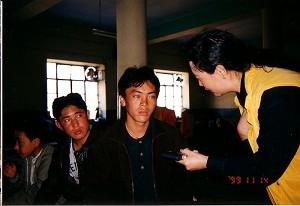
The Treacherous Passage of Refugees Across the Himalayas
Since 1989, every year approximately 2,000 Tibetans escaped from China to the refugee camp at the center of Dharamsala. Last year, the number doubled, jumping to 4,000. The afternoon of our arrival, for an interview we were met by Dawa Tsering, an official of Tibet’s government-in-exile Foreign Affairs and News Department.
The camp headquarters is a two-story building between two adjoining ones. The first floor has several rows of connected beds for the new refugees, who had recently escaped from China. Some female refugees live on the second floor. At the time, 70 to 80 Tibetan refugees who had recently escaped from China were living in the camp. Many of them were children and teenagers. Some of them were not accompanied by their parents, but had been entrusted to the care of other refugees.
When we walked into the camp, we were met with timid gazes from all. I sat down among the children to speak with a few of them, and they quickly became relaxed. Many of the children surrounded me, intent with curiosity. I started to distribute pens I had brought from Canada, and they all became excited. I started conversations with them.
I asked a boy around ten years old, “What is your name?”
He replied in pure mandarin,
“I am Sonanmido (phonic translation).”
“How old are you?”
“Fourteen.”
“Are you from Lhasa?”
“Yes, I escaped.”
“Did you escape with friends or by yourself?”
“By myself.”
“By yourself? It must have taken a long time. How long did it take?”
“It took me twenty-some days.”
“Twenty-some days. Were you afraid of being alone?”
“I was afraid, very afraid.”
“Afraid. What did you do when you were afraid?”
“I did not do anything but just hurry, and hurry.”
“Hurry. You wanted to hurry here, right?”
“Yes, hurry to see Dalai Lama.”
Looking at this 14-year old child, knowing he had hiked alone for over 20 days from Lhasa, over the rugged Himalayan Mountains, to Dharamsala, I knew he was among the fortunate ones to arrive at his destination, alive. To surmount the unforgiving Himalayas, which are covered by ice and snow year round, with a daunting elevation of 18,000 ft, any number of fates could await one -- one could encounter an avalanche, snow fissures, or could easily freeze or starve to death.
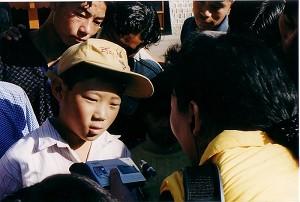
I turned to a young man in his twenties. He said his name was Badan Byangmtsho.
“Where are you from, and how long have you been here?”
“I am from Kangba in Ganzi, the autonomous region, in Sichuan Province. I have been here almost one month.”
“Why did you want to escape?”
“First, I wanted to meet Dalai Lama; and second, I wanted to come out to learn some skills and learn about culture.”
“Are you going back, after you’ve learned for awhile?” A 23 year-old painter broke in, saying, “No we won’t. We have already escaped, and will only go back to Tibet after it’s free.”
On the way to the camp, I had met a 14-year-old boy who did not want to ever go back to Tibet. His feet had been destroyed from frostbite when he made the treacherous trip over the Himalayas to come to Dharamsala.
When I had first met him, he was sitting on a rock, resting. He had curly, black hair, and his bright, dark eyes reflected profound sadness. As Xiang and I approached him, his eyes took us in with a cold, penetrating stare. I came up to greet him and asked how old he was. He looked away, and moving his lips ever so slightly, indifferently replied, “Fourteen.” I asked with a smile what he was doing. He said he was resting, and that he wanted to go to a hospital in Dharamsala to be treated. I asked why he needed treatment. He rolled up his trousers to show me the bandages on his two calves, which he used to secure shoes on his feet. The boy then unrolled the bandages and slowly removed his shoes, revealing two legs without feet.
I was shocked and speechless from what I saw. The boy replied softly, “They are this way from frostbite on my way to escaping here.”
Pain penetrated my heart. I couldn’t even imagine how such a young boy could climb across the world’s highest mountain range, the Himalayas, without feet.
I squatted down, gently holding up his legs, stumps with no feet. There were wrinkly scars on the wounded limbs. I told myself that I had to remember the scars, which were not only scars on the boy’s legs, but a marker on the road of the Tibetan people’s exile of over 40 years.
My distracted thoughts were brought back by arguments around me.
Xiang Xiaoji was talking with a young man, Doje Tsering, about whether Tibet should be independent and whether it could be independent. He had just escaped from Sichuan Province.
“My point of view is that Tibet can still be part of China, but we require a complete autonomy, democracy, freedoms, and human rights.” said Doje Tsering.
“So, you don’t want an independent Tibet, then?” asked Xiang.
“I didn’t mean that I don’t want independence. But there is very little hope for it.” Doje Tsering lowered his voice. “We are not talking about possible or not. We are talking about whether ideally we should or shouldn’t be independent.” Xiang remarked. Doje Tsering became silent. “Don’t be too theoretical, Xiang.” I half-jokingly interrupted.
Doje Tsering suddenly raised his voice, “I want us to be independent, very much.” Immediately his eyes filled with tears and his voice trembled as he spoke. “We Tibetans in the Chinese territory have suffered through and endured oppression. I really hope that we can be independent. We can rule our own country. We can guard the dignity of our race and our religion. I so want to be independent.” He was so upset and filled with remorse that Xiang and I had to wait for him to calm down. I told him that those of us who are displaced Chinese, Chinese of the diaspora, are also in exile and cannot go home, either, while China is not free. Under the totalitarian dictatorship in China, the Han people also have no freedom or dignity.
I asked him,“So you think that the independence of Tibet is still particularly important, if one day Tibet can have a genuine autonomy when the communist system in China is dissolved, meaning, that is, it becomes a democratic society?”
The young man was thoughtful for a moment and said, “I think that if China can really have human rights and democracy, if we can overthrow the Chinese Communist Party’s (CCP) hegemony and autocracy through our joint efforts, we can co-exist. In that case, I’m willing to stay in China and live and work with the Han people. I think by then, independence wouldn’t matter any more.”
Doje Tsering, who had arrived in Dharamsala for a mere dozen days, said that he had received the CCP’s brand of education since he was little. After he had grown up, he realized that the Tibetan history, religion, culture, and tradition he had learned from his parents is totally different from what he had learned in school. As a Tibetan, he cannot speak Tibetan, and he feels he knows less and less about who he is and the truth of his race. Thus, it occurred to him to learn all about Tibet elsewhere.“After leaving China, I came to realize that the Chinese people in China are miserable. Under the CCP’s autocratic system, they have little understanding of the outside world. I’m sorry that they still live in an environment where the news is completely controlled. I’m glad that I could escape. I really pity them.” said Doje Tsering.
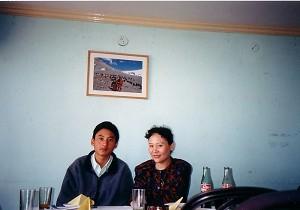
Samdrup, who had been imprisoned in China for 27 years, has cooked for the refugees in the refugee camp for 7 years. He told us that many refugees will attempt to escape to Dharamsala when winter arrives. “The Tibetans are used to living on the cold Tibetan plateau. It is difficult for them to adapt to the hot summer of India’s plains. Some Tibetans who fled to India in the summer were infected with diseases, and some even died. Another reason to escape in winter is that during the cold weather, the rivers leading to India are frozen. It’s easier to cross,” said Samdrup.“Every year many Tibetans freeze or starve to death when fleeing across the Himalayas, which is always covered in snow. Some people’s hands or feet were frozen and destroyed. They have become handicapped for life.”
Samdrup said that the refugees fleeing to Dharamsala have been taken good care of by the government-in-exile, which has established many services for them. Little refugees under 6 years old, who have no parents, will be sent to the orphanage. Children between 6-17 will be sent to the“Children’s Village.” They will study in a school in separate grades, according to age. Teenagers above 18 will be sent to learn at the “Adult Education School.” The elderly will be placed in a nursing home. All the costs of the above institutions are absorbed by the government-in-exile.
Samdrup said that all of the people who have escaped to Dharamsala will meet in groups personally with the Dalai Lama. Many people have even risked their lives to come here just to see the Dalai Lama. However, as the influx of refugees increases, it’s more and more difficult for the government-in-exile to afford the exorbitant expenses. So the government-in-exile has no choice but to persuade some people, after first having seen the Dalai Lama, to go back Tibet.
Dharamsala’s Interest in China’s Democracy
As the sun set on Dharamsala, a small mountain town in northern India it bears a striking resemblance of a night market in a Chinese village. People are seen walking on the town’s few bumpy streets, while shops and restaurants serve their customers.
We arrived in town at noon and invited our driver, Luosang—who had spent more than seven hours to pick us up and drive us up the mountain—to have lunch with us. We asked him to order an authentic Tibetan dish, and I ordered the same to have a taste of Tibetan cuisine. We waited for a long time. When two big bowls of hot noodle soup with shredded egg and meat were delivered from the kitchen, I was dumbfounded. I asked Luosang if this was a typical Tibetan dish. He just smiled and began to eat happily.
In the evening, I walked out of our hotel (a Tibetan establishment in the center of town) with my traveling companion, Xiang Xiaoji. I wanted to wander the streets, noticing that the downtown area was only a few hundred feet away. We wondered if we could find a restaurant at random to taste genuine Tibetan cuisine. Xiaoji and I stopped in front of a restaurant with flashing lights, worried that we might be entering an Indian restaurant by mistake. Then a very clear and confidant voice spoke behind us in Mandarin, “You’re Xiang Xiaoji, I know you. You are Xiang Xiaoji.” We turned in surprise. A handsome young man of just over 20 years old was staring at Xiaoji and smiling.
The young man introduced himself as Jiayang Dajie. He had read Xiang’s articles in the Beijing Spring magazine and had seen his picture before, so he could recognize Xiaoji right away. Xiaoji, who normally appears calm and keeps his countenance, was suddenly overwhelmed with various emotions. He had never imagined he could find an understanding friend in such a remote, small mountain town in a foreign land.
So Jiayang and his friend accompanied us for dinner. We had Hot and Sour Soup and Chow Mein. “Because India cannot grow barley, the local Tibetans eat similarly to the Han people. Actually even in Tibet, they eat pretty much the same way,” Jiayang said,
During dinner, Jiayang told us about his experience fleeing Tibet three times, twice reaching Dharamsala.
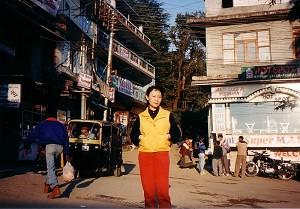
After the brother’s death, his younger sister was overcome with grief, and decided to give up and return home. She was soon caught by the border guards. As a consequence, Jiayang and his other two traveling companions were captured near the China-Nepal border by border guards on horseback. Jiayang’s first attempt at escape had failed.
After he was sent back to China, Jiayang immediately started to prepare for his second escape. This time, he organized a group of 20 to go with him. After one month and 28 days of hiking in ice and snow, they finally reached Nepal in February 2004. They arrived in Dharamsala where the Central Tibetan Administration is located.
On his way, Jiayang witnessed two nuns frozen to death and still standing in the snow covered Himalayas “They were so pitiful. Nobody knows who they are,” remembered, Jiayang. “Their family members will never know their whereabouts. In order to flee Tibet, many people met a similar fate.”
After living in Dharamsala for half a year, the 16-year-old Jiayang decided to return to Tibet. He saw so much of the outside world, and it was so different from what he had known before. He spent much of his time reading in the Dharamsala library, learning a wealth of new information. He read a large number of books on Tibetan history, culture and religious tradition, and materials on how the Chinese military entered Tibet and slaughtered its people. During that time period, Jiayang also read the Democratic China magazine published by a democratic organization in Japan, and began to learn about the movement in China. He came to realize that under the Chinese Communist Party’s totalitarian rule, the Chinese people share the same fate with the Tibetans. While the revelation was exciting, it also shocked him.
Jiayang returned home with a big rucksack containing 26 copies of “Democratic China” and many other books and recordings about the truth of Tibet’s history, including tapes and videos of the Dalai Lama.
He walked for 14 days and finally returned to Tibet. He distributed all of the books, magazines, tapes and videos to the Tibetans he met. Later, he was arrested and detained. Over a year and half he stayed in seven different detention centers. Finally, he got very sick in jail and was sent to the hospital for treatment. So he took the opportunity to flee for the third time.
Jiayang once again arrived at Dharamsala on January 1997. That’s when he read the “Beijing Spring” magazine, where he learned about the news of a democratic movement in China. This is a subject that concerns him greatly, because he has come to understand that Tibetans could have the freedom, dignity and the opportunity of true autonomy only if China achieved democracy. Jiayang also said he became very sad whenever he heard news of the infighting among democratic organizations.
Fleeing Should Not Be the Fate of Mankind
Now 22, Jiayang is a thin, handsome young man, but his life has been marked by fleeing since he was 16. Xiang Xiaoji is a very thoughtful person who rarely reveals his emotions. As he listened to Jiayang’s story he let out a few careful and heavy sighs. Although he didn’t say anything, I believe that the story tossed his heart around.
This naturally reminded me of the six cargo ships smuggling between 600 to 800 fugitives from China to Canada last summer. These overstuffed dilapidated vessels were rusting and had no life-saving facilities, drifted in the sea between two and three months. Everyone aboard would have certainly died if they had encountered any storms or craft malfuctions.
I also know very well that illegal Chinese immigrants not only set their sights on Canada, but towards Australia, New Zealand, the United States, and Mexico as well. They would set sail to any country that could give them a little bit of freedom, dignity, protection and hope for the future. Just like the Tibetan’s bloody footprints spread over the snowy Himalayas, the tide of Chinese illegal immigrants has been raging for a decade.
For years, terms, such as “sovereignty”, “territory”, “boundary” and “state” have begun to lose their meanings What the survival of mankind really depends upon is mother nature.
While there have been massacres and wars since the beginning of the human history, these people were fighting over resources for their own survival. Today, with the advances in technology and improvements in civilization, humans have discovered and created a wealth of resources for survival. However, the hatred, massacres, ruthless expulsion and extermination have never been decreased. These senseless killings are all because of protecting so-called “sovereignty,” safeguarding the sacred of “territory,” consolidating the “border” security—all to ensure the dignity of the “State.”
Today, I seriously question the meaning of these terms. The well-being of all people should be the highest principle—not just the powerful, the superior, or the special interest groups that wield power over other’s rights and survival. The only way to achieve this is to engender tolerance, respect and love among different ethnic groups, different cultures, and different historical backgrounds.
If “sovereignty” is only an excuse to bully the weak, if “territory” is only a sheer ostentation of power, if “boundary” is only an fence to seperate people, if “State” is only a machine to kill people—why do we need them? Are the soldiers deployed on the China-Nepal, China-Bhutan and China-Phnom Penh border to prevent these small countries from invading the giant China? No. Instead, the border posts are built to prevent Chinese people from fleeing China; the soldiers are deployed to search for the bloody footprints of fleeing Tibetans.
Is There a Future For These Happy Children?
A large number of Tibetan children and teenagers also escaped from China. Many of them fled without their parents’ accompany. Here is a story I heard in the refugee reception center. A village communist party secretary in Tibet decided to flee to Dharamsala. Many villagers who learned the news took their children to the secretary’s home and begged him to bring the children to Dharamsala. As a result, when the secretary arrived at Dharamsala, he brought children from 11 families in the village.
I wonder how many Tibetans in China pin their dreams on their children, and pin their children’s dream on this little mountain city, Dharamsala.
Dawa Tsering accompanied Mr. Xiang Xiaoji, me and Mr. Ni Yuxian who just arrived to visit the children’s village of Dharamsala. Dawa told us that the Tibetan government-in-exile built five children’s villages in India. He said 90% of the children were Tibetans who fled from Tibet and Qinghai, Sichuan, Gansu and Yunnan provinces of China. Most of the children’s parents are not here. Either they are orphans, or their parents are in China, he said.
The children’s village in Dharamsala houses about 10,000 children aged 6 to 13. They escaped from China, as we found out, mostly to seek better educations at the schools established by the Tibetan government-in-exile, particularly to study Tibetan language and to inherit Tibetan religion and culture.
When we arrived, the children were busy displaying their art works on a sunny hillside. The works were large stones on which they painted animals that best suited the natural look of the stones. There were paintings for cats, dogs, goats, rhinos, lions or tigers. Their painted very well. Dawa said the children were preparing to welcome His Holiness the Dalai Lama who would visit them the next day.
The children looked very happy and were busy enjoying their work.
I wanted to talk to some children. Dawa said children here were not like those in the refugee center who just arrived and mostly could speak Chinese. But children here, he said, had stayed here for a while and many could not speak Chinese any more.
I played my old trick again, mingling into the busy kids and chatting with them. Before long those who could speak Chinese started to show interest in me. They told me that they got up at 6:00 every morning, had breakfast 6:30, and had classes at 7:00. They study Tibetan, English and math. After lunch, the afternoon classes continue until 4:00 P.M., followed by play time. But most students preferred to spend that time also on finishing homework or studying, they said.
A boy called Dorje came to me and introduced himself, “I’m from Lhasa.” I chatted with him:
“How long have you been here?”
“Eight years.”
“Eight years! How come you still speak very good Chinese?”
“I didn’t leave Lhasa till the 7th grade.”
“Why did you come here?”
“My dad and mom wanted me to come to India to study.”
“Why do they want you to come to India to study?”
“Why? Because our Dalai Lama is here in India! He is the one we love most. And in India we can study Tibetan. So my parents wanted me to come here.”
“Are you happy here with your study and life? Have you learned what you want to learn? What do you want to do when you grow up?”
“I like English. When I grow up I want to go back home and become an English teacher.”
Another boy who looked to be eight or nine years old ran towards me and introduced himself with his lovely clear voice: “My name is Zhaxi Cairen.” He was really cute with big eyes and a slim chin. I asked him how long he had been here and whether he came with his parents. He told me he had been here for just a month. His parents, who are still in his hometown Qinghai Province, asked someone to bring him to Dharmsāla.
“How long did you travel on the road?”
“One month.”
“Why did your parents want you to come here to study? Do you know?”
“Here I can have a better study environment. I can study Tibetan language, moreover, I can learn English.”
“I will have the opportunity to see Dalai Lama,” he added, “I won’t be able to see Dalai Lama if I were still in China.”
“Did you learn Tibetan language when you were in China?”
“Very little. Mostly Chinese.”
“How many classes were Tibetan language and how many were Chinese language every day when you were at school in China?”
“We had four classes in the morning. Two of them were Chinese, one was math, the other on was Tibetan language.”
“Did you have a good life at hometown? Were you happy?
“No. My family needs to pay expensive tuition. Each semester we need to pay over 2,000 Yuan.”
“Your parents cannot afford your tuition. That’s why they decide to send you here to study. Is that right?”
“Yes. I can learn a lot of useful knowledge here. So when I grow up, I will be an educated person.”
“Do you miss you Mom and Dad?”
“Yes, very much so.”
“What’s to be done then? Do you want to go back home?”
“ I will return home after grow up. First of all, I need to study well at this village.”
Seventeen-year-old Suolan Dejie had lived in Dharmsāla for seven years. A fugitive brought her to India seven years ago when she was ten year old.
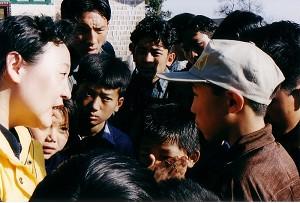
Although she told me she liked to live here very much, she also missed her parents. She could only write to her parents to tell them how much she longed to see them again. She hoped one day she will be able to return to Tibet.
We followed Dawa Cairen who took us to the residence o these children. Some of the residences had a wood placard which read “Little Norway” or “California, USA.” Dawa explained to us that thanks to financial support from many western countries, they were able to establish and maintain the Children’s Village, so that these fugitive Tibetan children can have a secure place to study and lead a peaceful life.
Everything is well-organized and flowed smoothly in the Children’s Village. These children are happy to be here. Nonetheless, it seems every child is dreaming about going back home one day.
However, Tibetans have led a fugitive life for 40 years. Presently there is not a single sign that affirmatively tells them their dream will come true.
Are these children predestined to be fugitives?
…
Being unable to go back to China for 10 years has always been a big pain in my heart. Although I always tell others I knew I had to pay a high price for confronting a totalitarian regime and I can pay that price, I always feel that pain in my heart.
…
After my visit to Dharmsāla, it adds to the pain in my heart. Upon returning home, I often sat in silence, trying to feel the struggle, the aspiration, the hope, the despair of Tibetans in the forty long years. I asked myself, when they decided to confront the totalitarian regime forty years ago, did they ever think about what kind of price it would cost them? Did they ever think about whether they can afford to pay that price?
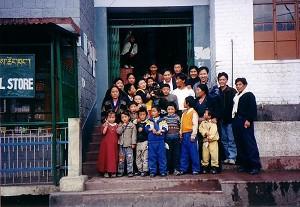

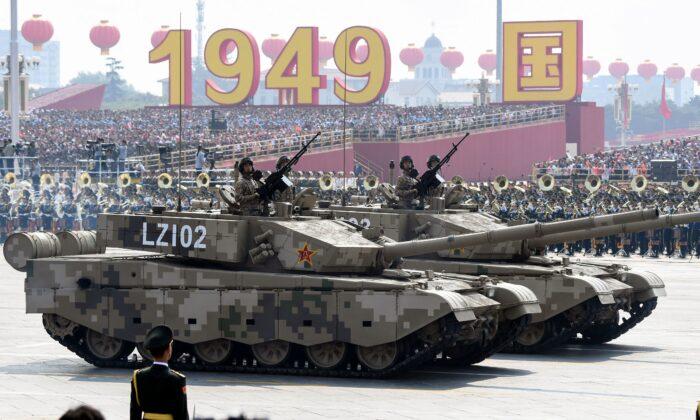


Friends Read Free